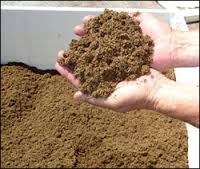 If you have not grown anything in Europe lately, you may not have noticed the battle going on between peat moss and coir. Well, it’s not actually a battle. More like a rout. Peat moss, which came into widespread use in the late 1940’s, has been vanquished back to its bogs. The reason: peat (or Sphagnum mosses) has been harvested so heavily that the bogs are disappearing. Because peat bogs store huge amounts of carbon from the atmosphere, the loss of peat bogs aids global warming. And peat bogs grow so slowly (less than 1mm – about 1/8″ per year), mining often strips off more than two meters (just over 6′) in one pass releasing tons of carbon into the atmosphere.
If you have not grown anything in Europe lately, you may not have noticed the battle going on between peat moss and coir. Well, it’s not actually a battle. More like a rout. Peat moss, which came into widespread use in the late 1940’s, has been vanquished back to its bogs. The reason: peat (or Sphagnum mosses) has been harvested so heavily that the bogs are disappearing. Because peat bogs store huge amounts of carbon from the atmosphere, the loss of peat bogs aids global warming. And peat bogs grow so slowly (less than 1mm – about 1/8″ per year), mining often strips off more than two meters (just over 6′) in one pass releasing tons of carbon into the atmosphere.
Coir on the other hand is replaceable. If you have ever stripped a freshly harvested coconut, you’ll have ripped off the hairy outer layer to get to the hard round shell. That outer fibrous layer, when shredded or finely ground is coir. Because coconuts are often harvested more than twice a year, coir is relatively plentiful.
However, there are similarities and differences.
Both are organic and both can help break down heavy soils. Peat moss is highly acidic with a ph of around 3.5 to 4.8, which gives it strong antiseptic properties, but when combined in a potting soil, limestone is often added to reduce the ph. Coir on the other hand, usually has a Ph of 5.5 to 7, but most coir is around 5.8 to 6.3, making it far more suitable for potting mixes without the need for additional limestone. (Ph varies according to the areas where the peat bog or coconut tree is located.) If you are planting acid loving plants such as rhododendrons, you might want to use peat moss as a soil amendment, but for alkaline loving plants such as clematis, you might want to add coir.
Both peat and coir can retain up to 20 times their weight in moisture. Thus, both help moisten soil. According to some advocates, coir holds water longer and releases it more slowly than peat moss, but most research seems to show similar results with only slightly slower release rates for Coir. A greenhouse owner might never notice a difference.
There have been some reports that coir might contribute more plant disease than the more acidic peat moss, but at the last New England Grows trade show the representative from Van der Knaap coir (www.vanderknaap.eu/en/), stated that their research  in the Netherlands shows that both are similar and coir may actually be slightly better. Until further research is done the jury will stay out on that particular battle.
in the Netherlands shows that both are similar and coir may actually be slightly better. Until further research is done the jury will stay out on that particular battle.
So it comes down to cost and availability. In Europe, peat moss has been legislated against and coir is king. In America, peat moss, mostly from Canada, seems to be the preferred medium, but many manufacturers are offering coir based potting mixes alongside their peat moss based mixes.


